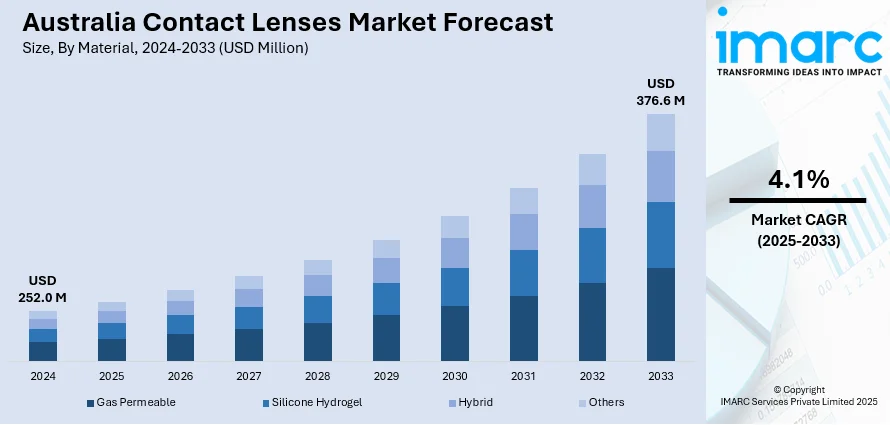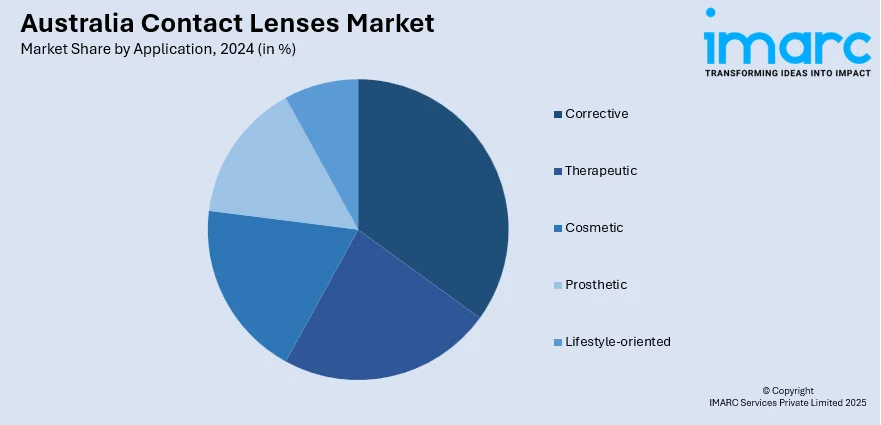
Australia Contact Lenses Market Size, Share, Trends and Forecast by Material, Design, Usage, Application, Distribution Channel, and Region, 2025-2033
Australia Contact Lenses Market Overview:
The Australia contact lenses market size reached USD 252.0 Million in 2024. Looking forward, IMARC Group expects the market to reach USD 376.6 Million by 2033, exhibiting a growth rate (CAGR) of 4.1% during 2025-2033. The market is fueled by enhanced demand for daily disposable lenses, heightened adoption for cosmetic purposes, and greater acceptance among mature users looking for advanced vision correction, comfort, and lifestyle-friendly options over conventional glasses.
|
Report Attribute
|
Key Statistics
|
|---|---|
|
Base Year
|
2024 |
|
Forecast Years
|
2025-2033
|
|
Historical Years
|
2019-2024
|
| Market Size in 2024 | USD 252.0 Million |
| Market Forecast in 2033 | USD 376.6 Million |
| Market Growth Rate 2025-2033 | 4.1% |
Australia Contact Lenses Market Trends:
Rising Demand for Daily Disposable Lenses
Australian consumer tastes are gradually gravitating towards daily disposable lenses because of the improved hygiene advantage, convenience, and lower risk of infection. The lenses require no cleaning agents or storage cases, which is particularly enticing for working professionals and young adults. Further, there has been increased awareness of eye care and preventive measures, and users are opting for methods that reduce the risk of complications. Retailers are reacting with wider assortments and promotion bundles, especially in metropolitan areas. Furthermore, the penetration of e-commerce has hastened access to subscription-based delivery platforms, stimulating repeat purchases. The Australia contact lenses market growth pattern demonstrates this shift toward high-frequency, short-duration products, particularly among first-time users and those in search of an alternative to eyeglasses. This trend is also assisted by the development of hydrogel and silicone hydrogel materials that enhance oxygen permeability and wearer comfort, thus making daily disposables the preferred choice in the premium segment.

Expanding Use of Lenses for Aesthetic and Lifestyle Needs
Apart from vision correction, Australia contact lenses market outlook is observing growing use for cosmetic and lifestyle applications. Patterned and colored lenses, once specialized, have become mainstream among young adults and social media influencers. The wish to change or enhance eye appearance for special occasions, photography, or everyday wear is driving steady demand. Regulatory transparency over non-prescription aesthetic lenses has also enabled their presence in optical outlets and beauty retailing spaces. The convergence of healthcare and personal fashion is attracting more consumers to the category. Innovation around moisture retention and longer wear has bridged the gap between comfort and style. The increasing role of digital marketing, online tutorials, and virtual try-on capabilities is also driving user interaction. This category is making a valuable contribution to the Australia contact lenses share, a reflection of larger shifts in consumer behavior where beauty and functionality walk hand-in-hand. For instance, in August 2024, Visioneering Technologies Inc. has appointed Gelflex as the distributor in Australia and New Zealand of its NaturalVue Multifocal contact lenses. The lenses feature an extended depth of focus design, which helps in myopia progression as well as presbyopia management.
Increased Adoption Among the Geriatric Population
Australia's geriatric population is highly embracing contact lenses, underpinned by advances in multifocal lens design and materials ideal for presbyopia treatment. According to the reports, in September 2024, Johnson & Johnson's TECNIS Odyssey intraocular lens was approved in Australia, pointing to growing demand for advanced vision correction options beyond contact lenses, particularly among presbyopic and cataract patients. Moreover, elderly persons who used to depend on spectacles are now switching to lenses that provide wider fields of view and minimize reliance on reading glasses. Advances in tear film stabilization and oxygen-permeable materials enhance wearability among older patients, with eye care professionals actively supporting trial programs to facilitate initial use. Educational outreach from clinics and community health programs has successfully removed misconceptions about the safety of lenses for older eyes. Additionally, the convenience of extended wear lenses is also winning over retirees in need of flexibility during travel or outdoor excursions. As this population continues to grow and become intensely health-focused, Australia contact lenses market share potential will increase steadily in coming years, indicating a more diversified customer base and demand profile.
Australia Contact Lenses Market Segmentation:
IMARC Group provides an analysis of the key trends in each segment of the market, along with forecasts at the region level for 2025-2033. Our report has categorized the market based on material, design, usage, application, and distribution channel.
Material Insights:
- Gas Permeable
- Silicone Hydrogel
- Hybrid
- Others
The report has provided a detailed breakup and analysis of the market based on the material. This includes gas permeable, silicone hydrogel, hybrid, and others.
Design Insights:
- Spherical
- Toric
- Multifocal
- Others
A detailed breakup and analysis of the market based on the design have also been provided in the report. This includes spherical, toric, multifocal, and others.
Usage Insights:
- Daily Disposable
- Disposable
- Frequently Replacement
- Traditional
The report has provided a detailed breakup and analysis of the market based on the usage. This includes daily disposable, disposable, frequently replacement, and traditional.
Application Insights:

- Corrective
- Therapeutic
- Cosmetic
- Prosthetic
- Lifestyle-oriented
A detailed breakup and analysis of the market based on the application have also been provided in the report. This includes corrective, therapeutic, cosmetic, prosthetic, and lifestyle-oriented.
Distribution Channel Insights:
- E-commerce
- Eye Care Practitioners
- Retail Stores
The report has provided a detailed breakup and analysis of the market based on the distribution channel. This includes e-commerce, eye care practitioners, and retail stores.
Regional Insights:
- Australia Capital Territory & New South Wales
- Victoria & Tasmania
- Queensland
- Northern Territory & Southern Australia
- Western Australia
The report has also provided a comprehensive analysis of all the major regional markets, which include Australia Capital Territory & New South Wales, Victoria & Tasmania, Queensland, Northern Territory & Southern Australia, and Western Australia.
Competitive Landscape:
The market research report has also provided a comprehensive analysis of the competitive landscape. Competitive analysis such as market structure, key player positioning, top winning strategies, competitive dashboard, and company evaluation quadrant has been covered in the report. Also, detailed profiles of all major companies have been provided.
Australia Contact Lenses Market News:
- In May 2024, Johnson & Johnson revealed the introduction of its ACUVUE OASYS MAX 1-Day Sphere and Multifocal contact lenses in Australia. Designed for today's digital lives, the lenses feature TearStable Technology, OptiBlue light filtering, and Pupil Optimised Design to provide consistent comfort, visual acuity, and performance at all distances.
- In June 2023, Alcon Vision Care introduced TOTAL30 monthly replaceable contact lenses in Australia and New Zealand available in sphere, toric, and multifocal forms with full ranges of power. The product is first to bring water gradient lens technology to the reusable category.
Australia Contact Lenses Market Report Coverage:
| Report Features | Details |
|---|---|
| Base Year of the Analysis | 2024 |
| Historical Period | 2019-2024 |
| Forecast Period | 2025-2033 |
| Units | Million USD |
| Scope of the Report |
Exploration of Historical Trends and Market Outlook, Industry Catalysts and Challenges, Segment-Wise Historical and Future Market Assessment:
|
| Materials Covered | Gas Permeable, Silicone Hydrogel, Hybrid, Others |
| Designs Covered | Spherical, Toric, Multifocal, Others |
| Usages Covered | Daily Disposable, Disposable, Frequently Replacement, Traditional |
| Applications Covered | Corrective, Therapeutic, Cosmetic, Prosthetic, Lifestyle-Oriented |
| Distribution Channels Covered | E-Commerce, Eye Care Practitioners, Retail Stores |
| Regions Covered | Australia Capital Territory & New South Wales, Victoria & Tasmania, Queensland, Northern Territory & Southern Australia, Western Australia |
| Customization Scope | 10% Free Customization |
| Post-Sale Analyst Support | 10-12 Weeks |
| Delivery Format | PDF and Excel through Email (We can also provide the editable version of the report in PPT/Word format on special request) |
Key Questions Answered in This Report:
- How has the Australia contact lenses market performed so far and how will it perform in the coming years?
- What is the breakup of the Australia contact lenses market on the basis of material?
- What is the breakup of the Australia contact lenses market on the basis of design?
- What is the breakup of the Australia contact lenses market on the basis of usage?
- What is the breakup of the Australia contact lenses market on the basis of application?
- What is the breakup of the Australia contact lenses market on the basis of distribution channel?
- What is the breakup of the Australia contact lenses market on the basis of region?
- What are the various stages in the value chain of the Australia contact lenses market?
- What are the key driving factors and challenges in the Australia contact lenses?
- What is the structure of the Australia contact lenses market and who are the key players?
- What is the degree of competition in the Australia contact lenses market?
Key Benefits for Stakeholders:
- IMARC’s industry report offers a comprehensive quantitative analysis of various market segments, historical and current market trends, market forecasts, and dynamics of the Australia contact lenses market from 2019-2033.
- The research report provides the latest information on the market drivers, challenges, and opportunities in the Australia contact lenses market.
- Porter's five forces analysis assist stakeholders in assessing the impact of new entrants, competitive rivalry, supplier power, buyer power, and the threat of substitution. It helps stakeholders to analyze the level of competition within the Australia contact lenses industry and its attractiveness.
- Competitive landscape allows stakeholders to understand their competitive environment and provides an insight into the current positions of key players in the market.
Need more help?
- Speak to our experienced analysts for insights on the current market scenarios.
- Include additional segments and countries to customize the report as per your requirement.
- Gain an unparalleled competitive advantage in your domain by understanding how to utilize the report and positively impacting your operations and revenue.
- For further assistance, please connect with our analysts.
 Inquire Before Buying
Inquire Before Buying
 Speak to an Analyst
Speak to an Analyst
 Request Brochure
Request Brochure
 Request Customization
Request Customization




.webp)




.webp)












